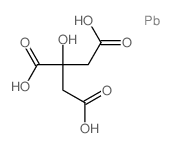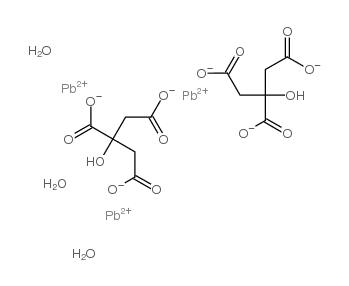柠檬酸铅, AR,Lead citrate
产品编号:西域试剂-WR363803| CAS NO:512-26-5| 分子式:C12H10O14Pb3| 分子量:999.8
本网站销售的所有产品仅用于工业应用或者科学研究等非医疗目的,不可用于人类或动物的临床诊断或者治疗,非药用,非食用,
| 英文名称 | Lead citrate |
|---|---|
| CAS编号 | 512-26-5 |
| 产品沸点 | 309.6ºC |
| 产品闪点 | 155.2ºC |
| 精确质量 | 400.00400 |
| PSA | 132.13000 |
| 外观性状 | 白色,无气味的晶体 |
| 溶解性 | soluble H2O; very slightly soluble alcohol [CRC10] |
| 稳定性 | 按规格使用和贮存,不会发生分解,避免与氧化物接触 |
| 储存条件 | 储存于阴凉、干燥、通风良好的库房。远离火种、热源。防止阳光直射。包装密封。应与酸类、食用化学品分开存放,切忌混储。储区应备有合适的材料收容泄漏物。 |
相关文档
化学品安全说明书(MSDS)
下载MSDS质检证书(COA)
相关产品
| 危害码 (欧洲) | N: Dangerous for the environment;T: Toxic; |
|---|---|
| 风险声明 (欧洲) | R20/22 |
| 安全声明 (欧洲) | 53-45-60-61 |
| 危险品运输编码 | UN 2291 6.1/PG 3 |
| WGK德国 | 3 |
| 包装等级 | III |
| 危险类别 | 6.1(b) |
Synonym:1,2,3-Propanetricarboxylic acid, 2-hydroxy-, lead(2+) salt (2:3); 1,2,3-Propanetricarboxylic acid, 2-hydroxy-, lead(2++) salt (2:3); Trilead dicitrat Section 2 - COMPOSITION, INFORMATION ON INGREDIENTS
Risk Phrases: 20/22 33 61 62 Section 3 - HAZARDS IDENTIFICATION EMERGENCY OVERVIEW
Harmful by inhalation and if swallowed. Danger of cumulative effects. May cause harm to the unborn child. Possible risk of impaired fertility. Potential Health Effects Eye: May cause eye irritation. Skin: May cause skin irritation. Harmful if absorbed through the skin. Ingestion: May cause severe digestive tract irritation with abdominal pain, nausea, vomiting and diarrhea. May cause headache. Exposure may cause anemia and other blood abnormalities. May cause degenerative brain changes. Ingestion of lead compounds can cause toxic effects in the blood-forming organs, kidneys and central nervous system. Acute lead poisoning can cause muscle weakness, "lead line" on the gums, metallic taste, definite loss of appetite, insomnia, dizziness, high lead levels in blood and urine with shock, coma and death in extreme cases. Inhalation: Harmful if inhaled. May cause effects similar to those described for ingestion. May cause respiratory tract irritation. May cause irritation of the mucous membranes. Chronic: May cause paralysis. Repeated exposure may cause nervous system abnormalities with muscle weakness and damage, motor incoordination, and sensation disturbances. Lead salts have been reported to cross the placenta and induce embryo- and feto- mortality. Section 4 - FIRST AID MEASURES Eyes: Immediately flush eyes with plenty of water for at least 15 minutes, occasionally lifting the upper and lower eyelids. Get medical aid immediately. Skin: Get medical aid immediately. Flush skin with plenty of water for at least 15 minutes while removing contaminated clothing and shoes. Discard contaminated clothing in a manner which limits further exposure. Destroy contaminated shoes. Ingestion: If victim is conscious and alert, give 2-4 cupfuls of milk or water. Never give anything by mouth to an unconscious person. Get medical aid immediately. Inhalation: Get medical aid immediately. Remove from exposure and move to fresh air immediately. Do not use mouth-to-mouth resuscitation if victim ingested or inhaled the substance; induce artificial respiration with the aid of a pocket mask equipped with a one-way valve or other proper respiratory medical device. Notes to Physician: Section 5 - FIRE FIGHTING MEASURES General Information: As in any fire, wear a self-contained breathing apparatus in pressure-demand, MSHA/NIOSH (approved or equivalent), and full protective gear. During a fire, irritating and highly toxic gases may be generated by thermal decomposition or combustion. Extinguishing Media: Use water spray, dry chemical, carbon dioxide, or appropriate foam. Section 6 - ACCIDENTAL RELEASE MEASURES General Information: Use proper personal protective equipment as indicated in Section 8. Spills/Leaks: Wash area with soap and water. Clean up spills immediately, observing precautions in the Protective Equipment section. Sweep up, then place into a suitable container for disposal. Avoid generating dusty conditions. Provide ventilation. Section 7 - HANDLING and STORAGE Handling: Wash thoroughly after handling. Remove contaminated clothing and wash before reuse. Avoid contact with eyes, skin, and clothing. Do not ingest or inhale. Use with adequate ventilation. Storage: Store in a cool, dry place. Keep containers tightly closed. Section 8 - EXPOSURE CONTROLS, PERSONAL PROTECTION Engineering Controls: Facilities storing or utilizing this material should be equipped with an eyewash facility and a safety shower. Use adequate general or local exhaust ventilation to keep airborne concentrations below the permissible exposure limits. Exposure Limits CAS# 512-26-5: United Kingdom, WEL - TWA: (listed as lead compounds): 0.15 mg/m3 (as Pb) United Kingdom, WEL - STEL: (listed as lead compounds): 0.45 mg/m TWA (as Pb) France - VME: (listed as lead compounds): 0.1 mg/m3 VME (as Pb) Germany: (listed as lead compounds): 0.1 mg/m3 VME (as Pb) Japan: (listed as lead compounds): 0.1 mg/m3 OEL (except alkyl le compounds, as Pb) Personal Protective Equipment Eyes: Wear chemical splash goggles. Skin: Wear appropriate protective gloves to prevent skin exposure. Clothing: Wear appropriate protective clothing to minimize contact with skin. Respirators: A respiratory protection program that meets OSHA's 29 CFR 1910.134 and ANSI Z88.2 requirements or European Standard EN 149 must be followed whenever workplace conditions warrant respirator use. Section 9 - PHYSICAL AND CHEMICAL PROPERTIES Physical State: Solid Color: white Odor: none reported pH: Not available. Vapor Pressure: Not available. Viscosity: Not available. Boiling Point: Not available. Freezing/Melting Point: Not available. Autoignition Temperature: Not applicable. Flash Point: Not applicable. Explosion Limits, lower: Not available. Explosion Limits, upper: Not available. Decomposition Temperature: Not available. Solubility in water: Not available. Specific Gravity/Density: Not available. Molecular Formula: C12H10O14Pb3.3H2O Molecular Weight: 1053.85 Section 10 - STABILITY AND REACTIVITY Chemical Stability: Stable under normal temperatures and pressures. Conditions to Avoid: Incompatible materials. Incompatibilities with Other Materials: Strong oxidizing agents, strong acids. Hazardous Decomposition Products: Carbon monoxide, carbon dioxide, lead/lead oxides. Hazardous Polymerization: Has not been reported Section 11 - TOXICOLOGICAL INFORMATION RTECS#: CAS# 512-26-5 unlisted. LD50/LC50: Not available. Carcinogenicity: 1,2,3-propanetricarboxylic acid, 2-hydroxy-,lead(2+)salt(2:3) - California: carcinogen, initial date 10/1/92 (listed as Lead compounds NTP: Suspect carcinogen (listed as Lead compounds). Section 12 - ECOLOGICAL INFORMATION Other No information available. Section 13 - DISPOSAL CONSIDERATIONS Dispose of in a manner consistent with federal, state, and local regulations. Section 14 - TRANSPORT INFORMATION IATA Shipping Name: LEAD COMPOUND, SOLUBLE, N.O.S. Hazard Class: 6.1 UN Number: 2291 Packing Group: III IMO Shipping Name: LEAD COMPOUND, SOLUBLE, N.O.S. Hazard Class: 6.1 UN Number: 2291 Packing Group: III RID/ADR Shipping Name: LEAD COMPOUND, SOLUBLE, N.O.S. Hazard Class: 6.1 UN Number: 2291 Packing group: III Section 15 - REGULATORY INFORMATION European/International Regulations European Labeling in Accordance with EC Directives Hazard Symbols: T Risk Phrases: R 61 May cause harm to the unborn child. R 20/22 Harmful by inhalation and if swallowed. R 33 Danger of cumulative effects. R 62 Possible risk of impaired fertility. Safety Phrases: S 53 Avoid exposure - obtain special instructions before use. S 45 In case of accident or if you feel unwell, seek medical advice immediately (show the label where possible). WGK (Water Danger/Protection) CAS# 512-26-5: No information available. Canada CAS# 512-26-5 is listed on Canada's DSL List. CAS# 512-26-5 is not listed on Canada's Ingredient Disclosure List. US FEDERAL TSCA CAS# 512-26-5 is listed on the TSCA inventory. SECTION 16 - ADDITIONAL INFORMATION N/A |
|
~% 
512-26-5 |
| 文献:Gmelin Handbook: Pb: MVol.C2, 216, page 802 - 804 |









 浙公网安备 33010802013016号
浙公网安备 33010802013016号